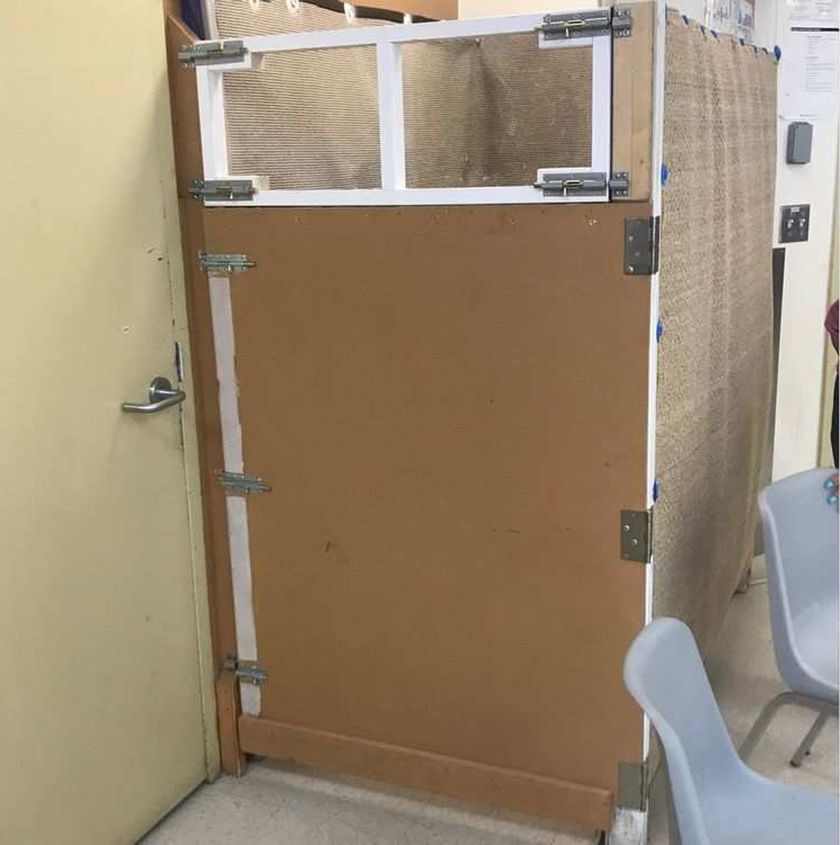
A seclusion room in an Alberta school
“This was inhumane. This was treating him like an animal,” said Marcy Oakes. “This” was, and is, an exclusion room, in this instance one in the Clover Bar Junior High School, part of the Elk Island Public Schools, in Sherwood Park, Alberta, Canada. According to Marcy Oakes and Warren Henschel, in 2015, their then-13-year-old son, Aidan, was dumped in a seclusion room. At some point later, someone looked in, and saw Aidan naked and covered in feces. The school took a photo, sent it to the parents, and told them to come fetch their son. Henschel remembers: “I could hear my son quietly whimpering. When I looked inside the room, it’s hard to describe my feelings.” Aidan is non-verbal and lives with autism and developmental disabilities. Mary Oakes explains, “My son does not take his clothes off willingly in a room unless he has been taught that. In the back of my mind, I will never know – because he can’t speak – how much they put him in that room.” Marcy Oakes and Warren Henschel are suing the Alberta government, the Elk Island Public School Board, the school’s principal, and the teacher. The School Board says it will “strongly defend the actions of our staff”. Who on the School Board strongly defends the lives of its students?
As a result of Aidan’s story, and others similar and worse, Inclusion Alberta launched an online survey to find out what exactly is going on in Alberta’s school systems. There’s no hard data on children being placed in seclusion rooms. The schools don’t keep records; the schools aren’t mandated to keep records. Additionally, there’s no set policy, other than vague “as a last resort” language, concerning the use of seclusion rooms. Just last week, Alberta Education Minister David Eggen announced that he expects the province to issue guidelines concerning the use of seclusion rooms within “a matter of weeks.” As of now, there’s only verbal night and fog. It’s not even clear if the Alberta government knows how many seclusion rooms there are, and what makes a seclusion room a seclusion room.
According to Bruce Uditsky, CEO Emeritus of Inclusion Alberta, speaking of the treatment Aidan suffered, “It’s not just about the use of seclusion in this instance; it’s about the abandonment and neglect and abuse that any of us would typically understand in any other circumstances, and how come it’s acceptable and tolerated in a school where we expect children to be safe and we’re to trust educators.”
Story after story, expert after expert, year in and year out, argue that seclusion rooms only serve to traumatize children and that there are better, evidence-proven ways of addressing `difficult behaviors.’ This year began with New Zealand outlawing the use of seclusion rooms in schools. In May 2018, Inclusion BC reported extensive and systemic use of seclusion rooms across British Columbia. This year’s report was a follow-up to a report in 2013, that led to voluntary guidelines finally being passed in 2015. According to Inclusion BC, only in three British Columbian school boards has adopted any policy concerning constraint and seclusion. And now it’s September, and Alberta “discovers” its lack of guidelines, which is it say, its policy of refusal.
Recently, a team of Canadian researchers studied “children’s moral experiences of crisis management in a child mental health setting.” The researchers asked children 12 and under living with severe disruptive disorders what they thought of the use of restraints and seclusion: “Children considered restraints and seclusion could help them feel safe in certain instances, for example if another child was being aggressive towards them or in exceptional cases to prevent self-injury. However, their own experiences of being restrained were predominantly negative, especially if not knowing the reason for their use, which they then found unfair. Some of the children emphasized the punitive nature of the use of restraints and seclusion, and most children disagreed with these practices when used as a punishment. Children’s perspectives also highlighted the limits of the use of a uniform de-escalation approach by the staff to manage crises. Children considered discussing with the staff and developing a relationship with them as more helpful in case of a crisis then the use of a de-escalation approach or coercive strategies.”
Seclusion rooms become part of the regular “arsenal” of education in response to budgets and resources. Staff are insufficiently trained to work with diverse populations, as the populations become increasingly diverse. Solitary confinement cells are built and children are thrown in. What do children learn in that process? Who cares? Who asks the children what they think? “This was inhumane. This was treating him like an animal.”
(Photo Credit: Sherwood Park News / Inclusion Alberta)